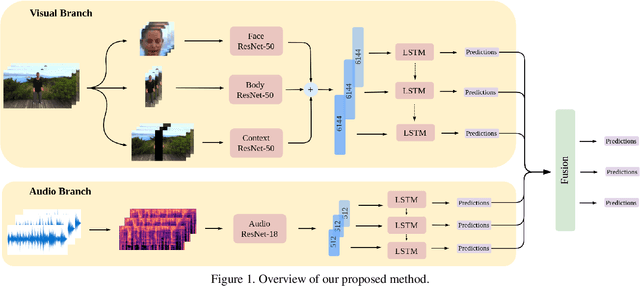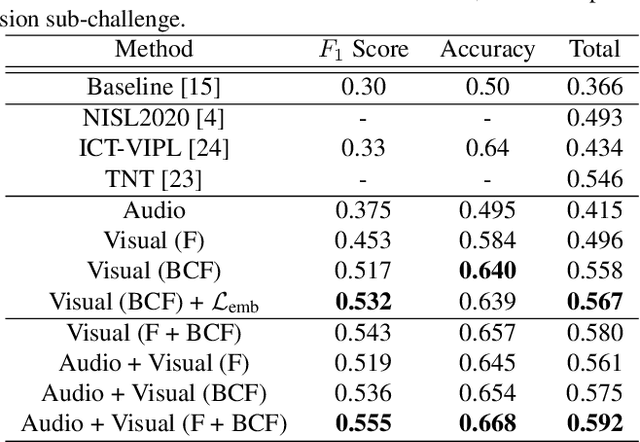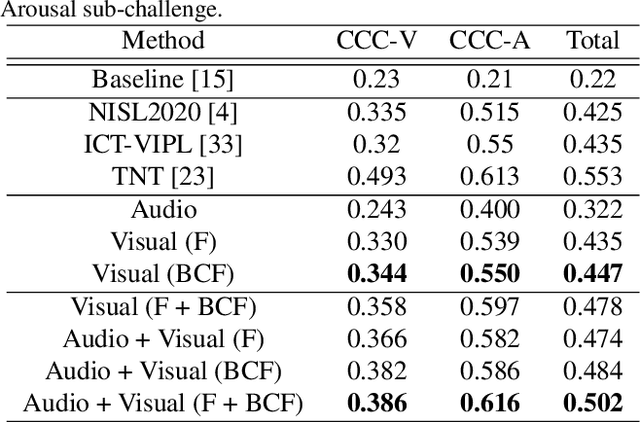Ioannis Pikoulis
Photorealistic and Identity-Preserving Image-Based Emotion Manipulation with Latent Diffusion Models
Aug 06, 2023



Abstract:In this paper, we investigate the emotion manipulation capabilities of diffusion models with "in-the-wild" images, a rather unexplored application area relative to the vast and rapidly growing literature for image-to-image translation tasks. Our proposed method encapsulates several pieces of prior work, with the most important being Latent Diffusion models and text-driven manipulation with CLIP latents. We conduct extensive qualitative and quantitative evaluations on AffectNet, demonstrating the superiority of our approach in terms of image quality and realism, while achieving competitive results relative to emotion translation compared to a variety of GAN-based counterparts. Code is released as a publicly available repo.
An audiovisual and contextual approach for categorical and continuous emotion recognition in-the-wild
Jul 10, 2021


Abstract:In this work we tackle the task of video-based audio-visual emotion recognition, within the premises of the 2nd Workshop and Competition on Affective Behavior Analysis in-the-wild (ABAW). Poor illumination conditions, head/body orientation and low image resolution constitute factors that can potentially hinder performance in case of methodologies that solely rely on the extraction and analysis of facial features. In order to alleviate this problem, we leverage bodily as well as contextual features, as part of a broader emotion recognition framework. We choose to use a standard CNN-RNN cascade as the backbone of our proposed model for sequence-to-sequence (seq2seq) learning. Apart from learning through the RGB input modality, we construct an aural stream which operates on sequences of extracted mel-spectrograms. Our extensive experiments on the challenging and newly assembled Affect-in-the-wild-2 (Aff-Wild2) dataset verify the superiority of our methods over existing approaches, while by properly incorporating all of the aforementioned modules in a network ensemble, we manage to surpass the previous best published recognition scores, in the official validation set. All the code was implemented using PyTorch\footnote{\url{https://pytorch.org/}} and is publicly available\footnote{\url{https://github.com/PanosAntoniadis/NTUA-ABAW2021}}.
Leveraging Semantic Scene Characteristics and Multi-Stream Convolutional Architectures in a Contextual Approach for Video-Based Visual Emotion Recognition in the Wild
May 16, 2021



Abstract:In this work we tackle the task of video-based visual emotion recognition in the wild. Standard methodologies that rely solely on the extraction of bodily and facial features often fall short of accurate emotion prediction in cases where the aforementioned sources of affective information are inaccessible due to head/body orientation, low resolution and poor illumination. We aspire to alleviate this problem by leveraging visual context in the form of scene characteristics and attributes, as part of a broader emotion recognition framework. Temporal Segment Networks (TSN) constitute the backbone of our proposed model. Apart from the RGB input modality, we make use of dense Optical Flow, following an intuitive multi-stream approach for a more effective encoding of motion. Furthermore, we shift our attention towards skeleton-based learning and leverage action-centric data as means of pre-training a Spatial-Temporal Graph Convolutional Network (ST-GCN) for the task of emotion recognition. Our extensive experiments on the challenging Body Language Dataset (BoLD) verify the superiority of our methods over existing approaches, while by properly incorporating all of the aforementioned modules in a network ensemble, we manage to surpass the previous best published recognition scores, by a large margin.
 Add to Chrome
Add to Chrome Add to Firefox
Add to Firefox Add to Edge
Add to Edge